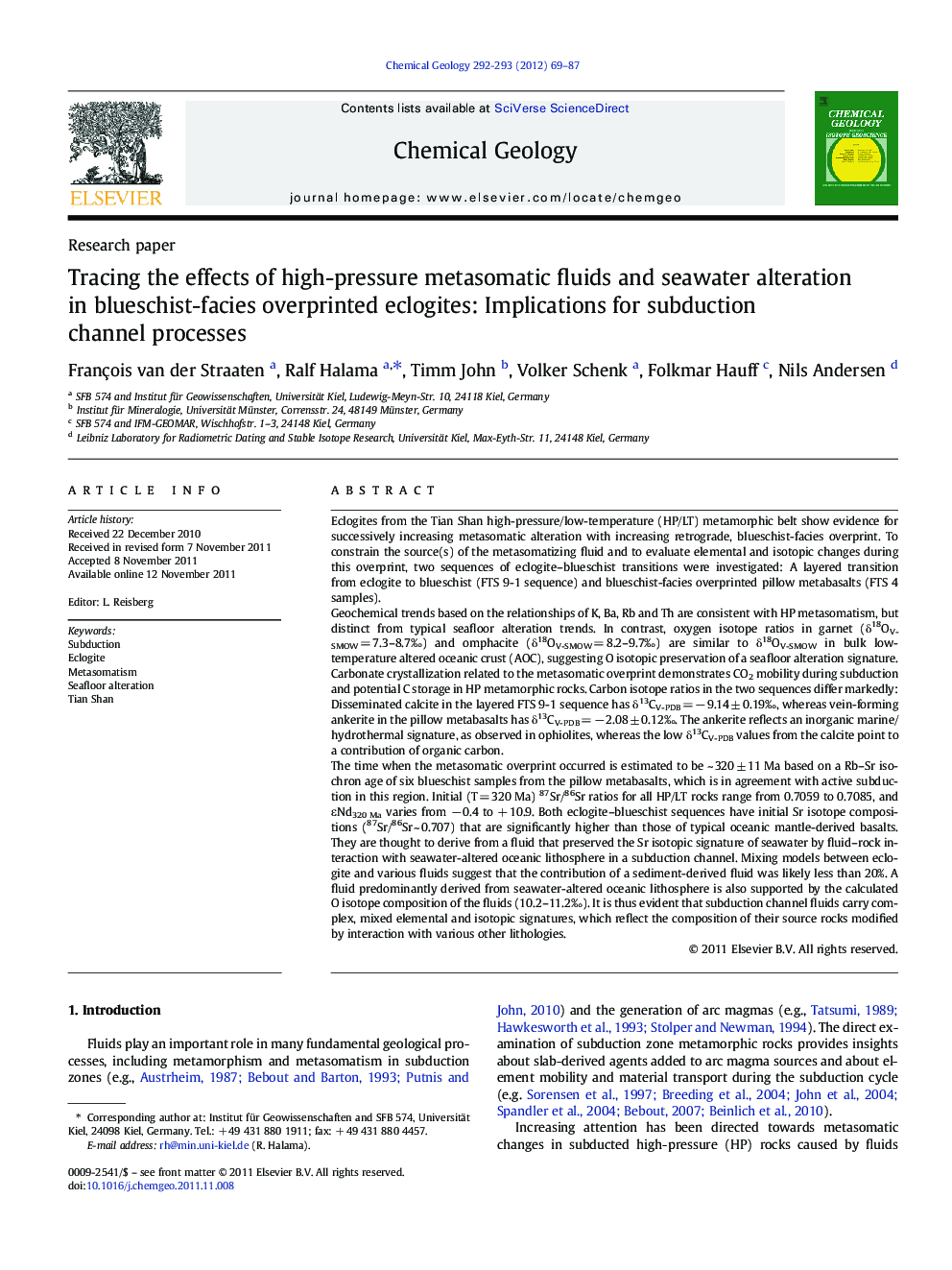| کد مقاله | کد نشریه | سال انتشار | مقاله انگلیسی | نسخه تمام متن |
|---|---|---|---|---|
| 4699554 | 1637654 | 2012 | 19 صفحه PDF | دانلود رایگان |

Eclogites from the Tian Shan high-pressure/low-temperature (HP/LT) metamorphic belt show evidence for successively increasing metasomatic alteration with increasing retrograde, blueschist-facies overprint. To constrain the source(s) of the metasomatizing fluid and to evaluate elemental and isotopic changes during this overprint, two sequences of eclogite–blueschist transitions were investigated: A layered transition from eclogite to blueschist (FTS 9-1 sequence) and blueschist-facies overprinted pillow metabasalts (FTS 4 samples).Geochemical trends based on the relationships of K, Ba, Rb and Th are consistent with HP metasomatism, but distinct from typical seafloor alteration trends. In contrast, oxygen isotope ratios in garnet (δ18OV-SMOW = 7.3–8.7‰) and omphacite (δ18OV-SMOW = 8.2–9.7‰) are similar to δ18OV-SMOW in bulk low-temperature altered oceanic crust (AOC), suggesting O isotopic preservation of a seafloor alteration signature. Carbonate crystallization related to the metasomatic overprint demonstrates CO2 mobility during subduction and potential C storage in HP metamorphic rocks. Carbon isotope ratios in the two sequences differ markedly: Disseminated calcite in the layered FTS 9-1 sequence has δ13CV-PDB = − 9.14 ± 0.19‰, whereas vein-forming ankerite in the pillow metabasalts has δ13CV-PDB = − 2.08 ± 0.12‰. The ankerite reflects an inorganic marine/hydrothermal signature, as observed in ophiolites, whereas the low δ13CV-PDB values from the calcite point to a contribution of organic carbon.The time when the metasomatic overprint occurred is estimated to be ~ 320 ± 11 Ma based on a Rb–Sr isochron age of six blueschist samples from the pillow metabasalts, which is in agreement with active subduction in this region. Initial (T = 320 Ma) 87Sr/86Sr ratios for all HP/LT rocks range from 0.7059 to 0.7085, and εNd320 Ma varies from − 0.4 to + 10.9. Both eclogite–blueschist sequences have initial Sr isotope compositions (87Sr/86Sr ~ 0.707) that are significantly higher than those of typical oceanic mantle-derived basalts. They are thought to derive from a fluid that preserved the Sr isotopic signature of seawater by fluid–rock interaction with seawater-altered oceanic lithosphere in a subduction channel. Mixing models between eclogite and various fluids suggest that the contribution of a sediment-derived fluid was likely less than 20%. A fluid predominantly derived from seawater-altered oceanic lithosphere is also supported by the calculated O isotope composition of the fluids (10.2–11.2‰). It is thus evident that subduction channel fluids carry complex, mixed elemental and isotopic signatures, which reflect the composition of their source rocks modified by interaction with various other lithologies.
► Eclogites from the Tian Shan show blueschist-facies metasomatic overprint.
► Fluid-induced metasomatism occurred at 320 ± 11 Ma.
► Fluid predominantly derived from seawater-altered oceanic lithosphere.
► Carbonates reflect C sequestration of mixture of organic and inorganic components.
Journal: Chemical Geology - Volumes 292–293, 23 January 2012, Pages 69–87